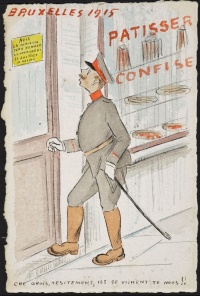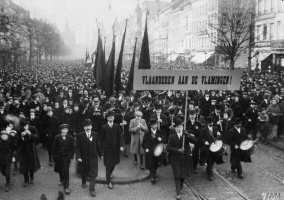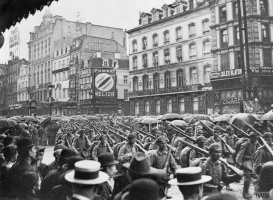A New Homeland↑
Before 1918, many Germans settled in Belgium. In 1910, about 63,000 Belgian inhabitants were of German or Austro-Hungarian origin. Most of them were German. In the port city of Antwerp, about 20,000 of them (which corresponded to 6 percent of the city’s population) had established a thriving German community. With an estimated 15,000 Germans, the community in Brussels was about equal in size to the one in Antwerp, but the Germans wielded considerably more power and influence in the latter city. For instance, the managers who ran the Red Star Line company in Antwerp, a passenger line that helped millions of Europeans emigrate to the United States, were German. Germans also settled in Liège and Verviers, but their number was much smaller and they were of a working class background, typically miners or metal workers. This stood in stark contrast to the more differentiated German colonies in Antwerp and Brussels with their dozens of different German schools, churches, cultural associations and various organisations.
In 1914, in addition to being the main harbour of colonial Belgium, the port city of Antwerp was a cosmopolitan hub with a modern kaleidoscopic population and a Hinterland that reached into parts of Germany such as the Rhineland. A lot of Germans had settled in Antwerp after the river Scheldt had become a toll-free river in 1863, had come in the wake of the Franco-Prussian war of 1870 or were attracted by the many trading and business opportunities.[1] Over time, however, they faced a dilemma: were they to remain Belgian Germans, German natives with a sense of belonging that still appertained more to native Germany, or were they to become German Belgians, with a loyalty to the new homeland?
Outbreak of War, Hostilities and Occupation↑
When hostilities started in August 1914, many Belgian inhabitants turned against their fellow citizens of German origin. No distinction was made between German Belgians and Belgian Germans. Many were forced to leave their ransacked homes. On 6 August, for instance, all Germans were forced to leave their home cities, and, in effect, the country as well. The anti-German atmosphere was pervasive. The Catholic newspaper La Métropole d’Anvers publicly criticised the liberal tolerance towards Germans in the years leading up to the war and even claimed that the influence of the German community had paved the way for the real German invasion. On 20 August, German soldiers entered Brussels, calling civil unrest against Germans to a halt there, but Antwerp only fell on 9 October. Here too, many temporarily displaced German families who returned to their homes found their houses and shops ransacked.
Antwerp belonged to the Occupationsgebiet, which was under German administration. Restoring the German community to its pre-war situation was one of the priorities of the German occupying forces, who established a Wohlfahrtsausschuss der deutschen Kolonie in February 1915, which had representatives of the German schools and churches in Antwerp among its members. Although some German families protested and did not take part in this restricted social fabric, most of them did.
Social life in occupied Belgium had become essentially more German. The Reichsmark had been introduced on 3 October 1914 and when the war of movement along the river Yser came to a halt, life in occupied Belgium entailed, for the next four years, a renegotiated relationship between Germans and Belgians. Despite the attempts of the German occupying forces to instigate an active Flemish nationalism with their Flamenpolitik, which led to the establishment of the Dutch-speaking University of Ghent and pro-German Flemish Council, most Belgian Germans were not adherents of the movement, as they tended to be more inclined towards the francophone Belgian liberal bourgeoisie. Belgians themselves had to rethink their attitude towards the German occupying forces, the German Belgians and German culture.
While many endured the limitations that the occupation had forced upon their society, a fair portion of Belgian civilians continued to enjoy their pre-war cultural cohabitation with Germans, although the focus shifted from interaction with the German communities to daily life as organised by the German occupation. One of the most noteworthy proponents of this overt orientation towards Germany, driven though it was by his Flemish nationalism, was the renowned Flemish poet Paul van Ostaijen (1896-1928), who frequented German cafés and, because of his Flemish nationalism, had to flee to Berlin by the end of the war. On a governmental level, relations were not restored after the 1914 invasion: the Belgian government in exile took part in the second Allied economic conference in Paris, in June 1916, where it was decided that trade links between Belgium and Germany would be diminished after the war.
Expulsion↑
The attitude of diminished involvement continued. On 10 November 1918, one day before the Armistice, the Belgian government installed a system of sequestration, whereby German possessions were disowned. Driven by anonymous letters that ratted out fellow Belgians of German origin, and by a nationalist sense of revenge, no distinction was made between Belgian Germans who had actively taken part in social life during the occupation, and German Belgians, often regardless of the latter’s displays of loyalty to Belgium during the war. Furthermore, by changing German names of public spaces to Belgian-sounding ones and because of the loss of German communities, especially in Antwerp – barely 300 people were registered after the war – and Brussels, the Belgian social fabric ultimately became more parochial. This was in spite of the East Cantons, Eupen-Malmédy, true German territory which had been annexed to Belgium in 1920 by the Versailles Treaty. The cosmopolitan nature of the port city of Antwerp and the core city of Europe, Brussels, had suffered a significant blow, and moved from a culture of inclusion to one of selective exclusion.
Christophe Declercq, University College London and University of Antwerp
Section Editor: Emmanuel Debruyne
Notes
- ↑ The first Belgian King, Leopold I, King of the Belgians (1790-1865), who hailed from Coburg, Bavaria, had already attributed a German element to Belgian public life.
Selected Bibliography
- Pelckmans, Geert / Doorslaer, Jan van: De Duitse kolonie in Antwerpen 1796-1914 (The German colony in Antwerp 1796-1914), Brasschaat; Kapellen 2000: Belgisch-Deutsche Gesellschaft Flandern; Pelckmans.
- Puschmann, Paul; Driessche, Nina Van den; Matthijs, Koen et al.: Paths of acculturation and social inclusion. Migration, marriage opportunities and assortative mating by geographic origin in Antwerp, 1846–1920, in: Journal of Migration History 2/1, 2016, pp. 177-207.
- Thooft, Gijs: Berlijn - Antwerpen. Economische en politieke aspiraties in Duitsland met betrekking tot de haven van Antwerpen (1886-1918) (Berlin - Antwerp. Economic and political aspirations in Germany with regards to the port of Antwerp (1886-1918)), thesis, Ghent 2001: Ghent University.
- Triest, Monika / Van Poucke, Guido: De oorlog na de Groote Oorlog. Anti-Duitse repressie in België na WO I (The war after the Great War. Anti-German repression in Belgium after WW1), Antwerp 2015: Polis.
- Vrints, Antoon: Bezette stad. Duitsers en activisten in Antwerpen (1914-1918) (Occupied city. Germans and activists in Antwerp (1914-1918)), thesis, Ghent 2000: Ghent University.
- Vrints, Antoon: De 'Klippen des Nationalismus'. De Eerste Wereldoorlog en de ondergang van de Duitse kolonie in Antwerpen (The First World War and the demise of the German colony in Antwerp), in: Bijdragen tot de Eigentijdse Geschiedenis - Cahiers d'histoire du temps présent 10, 2002, pp. 7-41.










